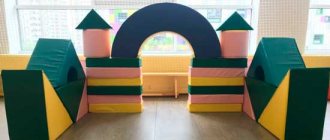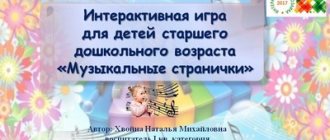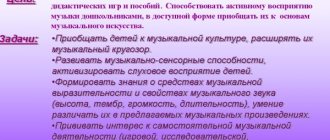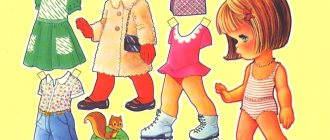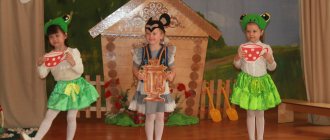Summary of the musical-didactic game in the senior group “What do I play?”
Irina Sosidka
Summary of the musical-didactic game in the senior group “What do I play?”
Purpose of the game: Development of timbre hearing.
Software tasks:
1. Improve the skill of playing musical instruments (keyboards, percussion and strings: piano, violin, cello, balalaika).
2. Develop children's creativity, encourage them to take active independent action.
3. To foster emotional responsiveness to music in children.
Game material: Cards (according to the number of players)
, on one half of which there is an image of children's musical instruments, the other half is empty; chips and children's musical instruments.
Progress of the game:
Children enter the hall to the music.
Teacher: Hello, guys! I found this cute box in the music room today. But I didn’t open it without you. What do you think might be in it? (Children's answers).
Teacher: Well, guess what, let’s open it together and take a look!
(Open them - there are cards, on one half of which musical instruments are depicted, and the other half is empty and chips).
Teacher : Guys, why do we need this?
Children: For playing.
Teacher: Of course, for the game. And you and I will play the game “What do I play on?” This is a game for developing timbre hearing.
The teacher distributes several cards to the children.
Teacher: For this game we will need a leader. Who wants to be the presenter? (All children raise their hand)
. Let's do it in such a way as not to quarrel, using a counting rhyme we will choose a leader:
“One day a mouse came out to see what time it was.
One, two, three, four, the mouse pulled the weights.
Suddenly there was a loud ringing sound, get out of the circle!”
Teacher: Nikita is our leader, for this game he will have to play a melody or rhythmic pattern on any instrument at his discretion behind this screen (there is a small screen in front of the leader)
. And you guys must determine the sound of this instrument and cover the second half of the card with a chip. It's clear? Then we start playing.
(They play several times, the child leader changes with the help of a counting rhyme, or the child who closed his cards faster than the others becomes the leader).
Teacher: Our game is over, let's put all the attributes back in the box. Guys, did you like the game? What exactly did you like about it? Was it easy for you to recognize the sound of musical instruments? Who found it difficult? Who was unhappy? Who wants to play this game again next time? You guys tried really hard, well done!
Summary of the musical and didactic game “Sun and Cloud”
Synopsis of a musical and didactic game
“Sun and Cloud”
Volgodonsk
2015
Target:
Develop an understanding of the different nature of music (cheerful, cheerful; calm, lullaby; sad, melancholy).
Tasks:
Encourage to perceive the expressiveness of music, its feelings.
To develop the ability to express emotions and the character of a musical work through game cards.
To develop musical memory, children’s understanding of the different nature of music (cheerful, calm, sad).
Develop auditory perception, elementary musical and analytical thinking.
Develop the ability to compare and contrast music of different types.
Game material:
cards according to the number of players: bright sun, sun covered by a cloud, cloud with rain.
Progress of the game:
Educator:
Guys, do you like listening to music? Does anyone know what kind of music there is in character?
Children:
Cheerful, sad, calm, sad...
Educator:
Guys, what else can you say, funny, sad, sad?
Children:
Mood
Educator:
Show a cheerful mood using facial expressions; then sad; sad. Well done.
Now we will listen to music, and I invite you
to play the game “Sun and Cloud”.
Listen to the rules of the game:
If you hear cheerful music, raise the “sun”.
If I’m cheerful, it’s “sunshine.”
If it’s sad, “the sun is behind the cloud.”
If you're angry
, sounds of a thunderstorm - “cloud with rain”.
Listen carefully to the music and show the correct card.
Remember the rules of the game: There is no need to speak words, just show the card.
Educator:
1 composition: ……………………….
Children:
show a cloud
Educator:
“Why did they show the cloud? »
Children:
The music sounded sad, gloomy, plaintive
Educator:
Look guys, did you all answer correctly? (slide)
Composition 2: …………………..
Children:
show the sun
Educator:
What kind of music was it?
Children:
Cheerful, joyful
Educator:
Pay attention to the screen, whoever chose the same card made the right choice.
Composition 3: ………………….
Children:
show the sun behind the cloud.
Educator:
Well done boys. Look, we have 3 very interesting paintings. What can you say about the first/second/third picture?
Guys, look, I have 2 cards, which card should we attach to 1 picture?
Children:
Rain
Educator:
What about the second?
Children:
The sun behind the cloud.
Educator:
You and I have a third picture, where it is very light, day is depicted, birds are flying. Which card can be attributed to this picture?
Children:
Sun.
Educator:
But I don't have a card for this picture. Who knows what we can do with you so that our picture has a card?
Children:
draw.
Educator:
That's right guys, you and I will draw the sun.
But in order for you and me to draw the sun, we need to go to the workshop and become real artists. And for this we need to say our magic words: Kribli, krabble, boom.
- So you and I became artists. We sit down at the tables.
— Take a seat at your desk.
- We want to draw, but we don’t have pencils and paints, what can we use to draw with? And we will draw with the help of cotton swabs. To make the sun look like a real one, let’s remember what it is like. What does it look like? (Children's answers.)
Educator:
- What geometric figure does the sun remind us of? (Children's answers.)
- What color is the sun? (Children's answers.)
- That's right, guys. And in order for you and me to have a beautiful and bright sun, we need to do exercises for our pens:
Finger gymnastics “Give us warmth, sunshine”
We extended our palms
And they looked at the sun. (Children stretch their palms forward and rhythmically turn them up and down.)
Give us warmth, sunshine,
So that there is strength. (They make a movement with their fingers, as if beckoning to them.)
Our fingers are tiny
They don’t want to wait a minute, (They rhythmically bend and straighten their fingers.)
Knock - knock, with hammers, (Bend over and alternately rhythmically knock on their knees with their fists.)
Clap - clap, with little paws, (They clap their knees rhythmically.)
Jump - jump like bunnies,
Jumping on the lawn. (They tap their knees with bent fingers.)
Now, move the leaves towards you. Each of you has yellow paint, cotton swabs and napkins on the table.
— In order to draw a sun, you need to put a little paint on the tip of a cotton swab and, using these movements, first draw the outline of the sun, that is, a circle. Our circle is ready, what is the sun missing?
- I think the same guys, rays. We draw rays in the same way, look like this.
- That's how beautiful it works out for you and me.
- Whoever has finished, put a cotton swab on a napkin and hang your work on the picture.
- And now it’s time for you and me to return to kindergarten. Let's say the magic words: cribli, crabli, boom.
- Here we are in kindergarten. You can attach a picture of your sun to your locker or take it home. The sun will warm you in cloudy and cold weather and create a good mood.
- Now let’s smile at each other and go for a walk to the cheerful music.
Musical and didactic game “Musical House” for the older group (5-6 years old)
Construct of joint educational activities
according to PM 02 Organization of various types of activities and communication of preschool children
Novikova Elizaveta Artemovna 33A group
Date of:
09.03.21
DOO:
"Kindergarten No. 9"
Age group:
eldest (5-6 years old).
Educators:
Shmidt Marina Aleksandrovna, Voinkova Irina Valerievna
Head of practice:
Ibragimova Daria Andreevna
Methodist:
Sirazheva Elza Garafovna
Kind of activity:
musical didactic game.
Form of organization:
group
Subject:
Musical and didactic game “Musical House”
Game goal:
Development in children the ability to distinguish the timbre of various children's musical instruments
Game rule:
Children sit on the carpet in front of the music house and name the musical instrument without looking behind the music house.
Game action:
Children listen to a simple melody and name a musical instrument
Target:
Development in children the ability to distinguish the timbre of various children's musical instruments
Planned result:
Children show a desire to interact with peers;
Children know musical instruments;
Children develop creativity;
Children develop musical abilities: pitch, rhythmic, timbre, dynamic hearing;
Children can distinguish the timbre of musical instruments;
Children show interest in musical and artistic activities.
children show independence and activity.
| Objectives of joint musical activities | Tasks taking into account the individual characteristics of children |
| Educational: Cultivate interest in musical and artistic activities; Foster the desire and ability to interact with peers. Educational: Strengthen knowledge about musical instruments. Teach children to distinguish the timbre of instruments. (Knocking timbre: wooden spoons, xylophone, drum; ringing: tambourine; rustling: maracas) develop musical abilities; promote activity and independently. Educational: Develop children's creativity, encourage them to take active independent action; Continue to develop children’s musical abilities: pitch, rhythmic, timbre, dynamic hearing; | Masha - to develop musical abilities. |
List of used literature:
•From birth to school: an approximate general educational program for preschool education/N. E. Veraksa, T.S. Komarova, M.A. Vasilyeva
“PUBLISHING HOUSE “MOSAIC-SYNTHESIS”, Moscow 2014. -340 pp., Federal State Educational Standards of Education
•Federal State Educational Standard for Preschool Education [Text]: approved by the Ministry of Education and Science of the Russian Federation dated October 17, 2013 No. 1155. – Kamensk-Uralsky: GBOU SPO SO “Kamensk-Ural Pedagogical College”, 2014. – 36 p.
Summary of the musical and didactic game “Knock, knock with a hammer” in the senior group
Synopsis of a musical didactic game.
Lesson summary (GCD)
Technological map of organized educational activities
in
the older group.
Group: senior
Educational field: Music
Section: “Performance”, “Playing children’s musical instruments”
Topic: “Knock, knock with a hammer”
Goal: To develop children’s understanding of rhythm, teach them to remember and convey a given rhythmic pattern.
Tasks:
Educational:
-improving the child’s aesthetic perception and feelings;
-continue acquaintance with children's musical instruments and teaching children to play them;
-continue to teach and develop a sense of rhythm and harmonic hearing
Educational:
-continue to develop coordination of musical thinking and motor functions of the body;
-consolidate acquired knowledge in independent actions
Educational:
— to cultivate in children a love for the art of music and to develop an interest in music
Methods:
-Verbal:
conversation, answers to questions, explanation, praise, instructions
-Visual: showing illustrations of musical instruments, showing how to play a musical instrument with a hammer
-Practical:
reproduction of a rhythmic pattern, first in claps, then on musical instruments
-Equipment:
Illustrations with musical instruments, hammer, tablet
-Predicted results:
Know: musical instruments, distinguish musical instruments by timbre sound
Be able to: play children's musical instruments, individually and in an ensemble, reproduce the rhythmic pattern of a melody in clapping, on musical instruments
Have experience: knowledge of a musical instrument such as a hammer and a plank, playing this instrument, consolidation of the material covered
The course of the musical-didactic game
| Stages of activity | Teacher's actions | Children's actions |
| Motivational - incentive | Hello guys, today we will play with you a musical game called “Knock, knock with a hammer.” First, let's remember what musical instruments you know. I will show the tool in the picture, and you will show its name. Well done! You know all the musical instruments. | Children's answers |
| Organizationally – search | -And today I want to introduce you to a musical instrument called a hammer, and it comes with a plate on which the rhythm is struck with this hammer. -What does this instrument look like? -That's right, but it's a musical hammer. And with this instrument you can play a song. But first, let's get acquainted with it. The teacher begins to knock on the board with a hammer, causing sounds. Then he invites those who want to try playing this instrument. -You can use this instrument to make a long sound (slow), this is how it sounds, or you can make a short sound (fast sound), this is what it sounds like. Next, he calls on the children to repeat the sounds using this instrument. Well done!!!! You completed the task. And now I’ll sing a song and play this instrument, and you listen. “Knock, knock with a hammer, we’ll build a house for the birds, Knock, knock with a hammer, let the birds settle in it (2 rubles)" You listened to this song, tell me what sounds you heard? Maybe short, or maybe only long, or are there short and long sounds? -That's right, there are both short and long sounds. -Now let's clap our hands for this song. I show, you listen, I show, you clap. Well done! Next, the teacher shows a rhythmic pattern using a hammer and a board. | Children look at a musical instrument. Children's answers: -on a hammer that hammers nails. Children go out and repeat the teacher’s actions. Then they sit down in their places. Children listen carefully to the teacher. When called by the teacher, the child goes out and repeats the teacher’s actions. Children sit and listen carefully to the teacher Children's answers. Children listen to the teacher, and then repeat the rhythmic pattern, clapping their hands, one at a time, together. After the show, the children perform a rhythmic pattern on a musical instrument, first one at a time, then together as an ensemble. |
| Reflexively - corrective | The teacher praises the children. -Well done guys, today you learned to play the musical hammer. Asks questions about what you did, what you liked doing, what caused difficulties, and what was the easiest? | Children's answers. |
Analysis: The structure of the lesson is designed taking into account the age and musical development of children. Practical, verbal, and visual methods of work were used in the work, which made it possible to more clearly convey knowledge to children. The teacher managed to arouse emotional interest in the lesson. The children were active throughout the lesson. The set goals and objectives were completed. All structural parts of the lesson were observed. The children themselves were participants in the game moments and were active helpers. The program content of the lesson corresponds to the assigned tasks. The time for each part of the lesson was correctly observed. Praise was also used. The outcome of the lesson was carried out expediently. Analyzing the lesson, we can conclude: the assigned tasks and goals were completed.
Used Books:
1. Kostina E. P. Musical and didactic games [Text] E. P. Kostina / Rostov-on-Don: “Phoenix”. Series: I give my heart to children, 2010 -212s
2. Approximate general educational program for preschool education FROM BIRTH TO SCHOOL [Text] / Ed. N. E. Veraksy, T. S. Komarova, M. A. Vasilyeva. - M.: MOSAIKA-SYNTHESIS, 2014. - 368 p.
Summary of the musical and didactic game “Learn the Instrument”
Olesya Karikova
Summary of the musical and didactic game “Learn the instrument”
Software tasks:
1. Fix the names of musical instruments
2. Develop timbre hearing
3. Develop rhythmic hearing
4. Develop an interest in executive activities
5. Cultivate interest in musical art
Game material:
1. Children's musical instruments : (2 sets)
2. Table screen
3. Cards with images of musical instruments (size 8cm/10)
by the number of children in the group.
-Guys, now we are going to play the game “ Find out the instrument ”. Tell me what musical instruments you know (tambourine, drum.)
-Fine! a lot of musical instruments (I show musical instruments and the children say their names). Now remember how they sound (I play musical instruments )
.
(I hand out cards with pictures of musical instruments )
-Now, behind the screen, I will alternately play different musical instruments , and you will hold up a card with the image of the instrument that sounds (play)
.
-Well done! Now let's complicate our game. I will play a musical instrument , and one of you will listen carefully and determine what musical instrument I played . He will find the same instrument and play the same rhythm as I play.
-Well done boys! Today you made me very happy, I realized that you know a lot of musical instruments and know their sound well!
Summary of the didactic game for children 6–7 years old “Here comes the little man” Didactic game “Here comes the little man” Purpose: the formation of logical thinking through the study of parts of the human body. Tasks: To consolidate.
Summary of the didactic game “Guess the Bird” using a computer presentation for older preschoolers As part of the implementation of the project “Wintering Birds of Our Region - Ugra,” I developed a didactic game “Guess the Bird” for older preschoolers.
Synopsis of the didactic game "Loto" Plan-summary of the didactic game Name of the game "Loto". Type of game Didactic task to teach finding paired pictures; develop attention;
Synopsis of the didactic game “Flight into Space” Synopsis of the didactic game “Flight into Space” Preparatory group for school Purpose: To identify children’s knowledge about space, about astronauts, about the first.
Summary of the didactic game in the senior group “Wild Animals” Goal: Replenish and activate the vocabulary on the topic: “Wild Animals” Objectives: clarify ideas about the habitat of wild animals, their food.
Summary of the didactic game in the senior group “Professions” Purpose: to clarify children’s ideas about different professions, about their work actions and about the objects of their work. Expand and activate your vocabulary.
Summary of the didactic game “Guess What's Inside” on speech development Program objectives 1. Teach children to distinguish and name vegetables, highlight their characteristic features (color, shape, taste, surface). 2. Activate.
Master class on making a musical and didactic game for children from 2 to 4 years old “Fairy-tale inhabitants of an amazing tower” Dear colleagues! I present to you a master class on making two-story houses and characters from the musical repertoire for development.
Master class with parents “Making a musical and didactic game” The master class is aimed at cooperation with parents. Purpose: musical and didactic game, made with your own hands. Purpose: use.
Source

